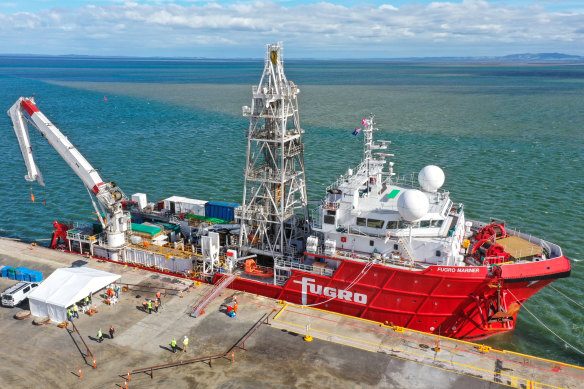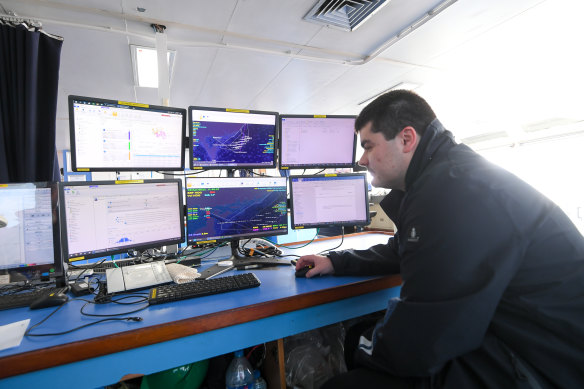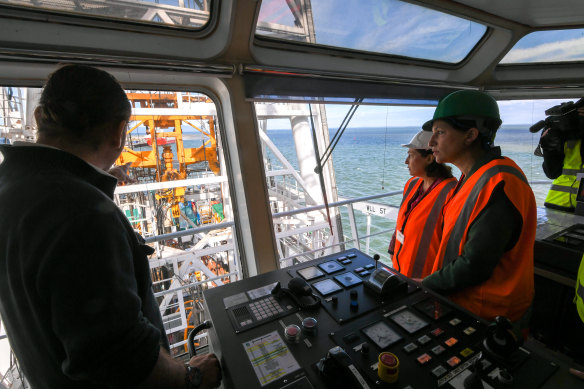This was published 2 years ago
Seabed drilling kick-starts Australia’s offshore wind race
By Miki Perkins
Seabed drilling has started in the Bass Strait to test the feasibility of Australia’s most advanced offshore wind farm proposal, the Star of the South project off the coast of Southern Gippsland.
A specialist drill vessel, the Fugro Mariner, and crew will spend the next five weeks at sea collecting soil and rock samples from up to 70 metres below the sea floor at 22 different locations.

The Fugro Mariner will spend the next five weeks at sea. Credit: Justin McManus
These are the first geotechnical investigations undertaken for any offshore wind project in Australia, with the results of local seabed conditions to guide the design of the huge wind farm.
Star of the South chief executive Charles Rattray said these surveys, being undertaken by contractor Fugro at the cost of tens of millions of dollars, would guide feasibility assessments for the pioneering project. The Victorian government has provided $19.5 million in funding towards investigative work.
“Knowing what’s under the seabed in this specific location helps ensure everything we do – from turbine design and placement through to construction methods,” Rattray said.
“What we’re seeing in Australia – and most notably in Victoria – are the right policy settings being set such that investors such as ours can make these types of decisions.”

The Star of the South project would be one of Australia’s most advanced offshore wind farms.Credit: Justin McManus
The Star of the South, which would comprise about 150 turbine towers about 350 metres tall, is proposed to be located off the south coast of Gippsland, near towns such as Port Albert, McLoughlins Beach and Woodside Beach. The project is being developed by green fund manager Copenhagen Infrastructure Partners, Cbus and Australian partners.
If Star of the South is approved, construction could start about the middle of this decade, with the first power before 2030 to align with the planned closure of Latrobe Valley coal power plants.
The Victorian offshore wind industry, which the government claims will create 59,000 jobs by 2035, is seen as less politically risky than onshore wind because it minimises the risk of a backlash from local communities. But it will also be comparatively expensive.
The Victorian government has a target to generate at least two gigawatts of power from offshore wind by 2032 – about 20 per cent of the state’s total power and enough to power 1.5 million homes. This is planned to double to four gigawatts by 2035 and increase to nine gigawatts by 2040.

Energy Minister Lily D’Ambrosio with Fugro regional director Shalu Shajahan and Star of the South CEO Charles Rattray on board the Fugro Mariner. Credit: Justin McManus
Minister for Energy Lily D’Ambrosio has released two offshore wind “implementation statements” to the market that confirmed the state government would go to tender for the first offshore wind energy projects from mid-2024, with projects to be selected by mid-2025.
The Port of Hastings will be the primary construction site for wind farms, but there would also be a role for a number of other ports to provide support to the growing industry, D’Ambrosio said.
“This will be the first marine geotechnical campaign in Australia for offshore wind energy, which is a huge achievement for Victoria as it makes the transition from coal to renewables,” she said.
A spokesperson for Fugro described the drilling as “environmentally safe”, saying the company had carried out numerous drilling surveys for offshore wind projects all over the world.
Previous seabed surveys over the past two years had provided geophysical information in the area that allowed drilling to avoid reefs and other marine habitat, he said.
Fishing and recreational boats can continue using the area while investigations are under way, as long as they keep a safe distance from the Fugro Mariner.
Get to the heart of what’s happening with climate change and the environment. Our fortnightly Environment newsletter brings you the news, the issues and the solutions. Sign up here.